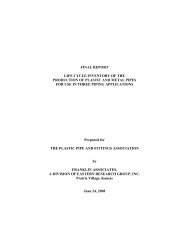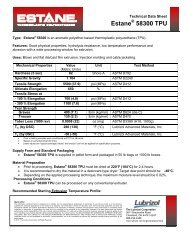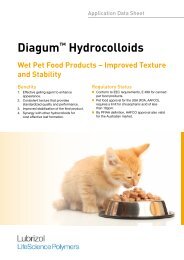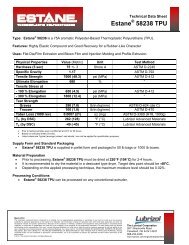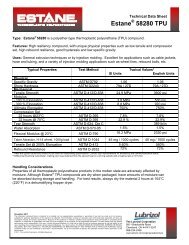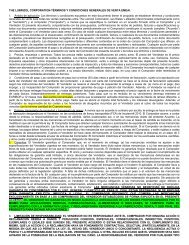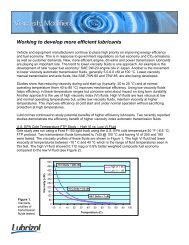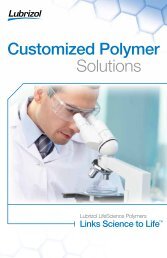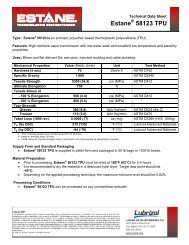The Value of Performance - Lubrizol
The Value of Performance - Lubrizol
The Value of Performance - Lubrizol
You also want an ePaper? Increase the reach of your titles
YUMPU automatically turns print PDFs into web optimized ePapers that Google loves.
<strong>The</strong> <strong>Value</strong> <strong>of</strong> <strong>Performance</strong><br />
Engine Oils Marketing – October 2011<br />
UEIL<br />
© <strong>The</strong> <strong>Lubrizol</strong> Corporation 2011, all rights reserved
<strong>The</strong> Year is 1994<br />
• Brazil win the Soccer World Cup<br />
• OJ Simpson is facing charges in<br />
the US court system<br />
• <strong>The</strong> Channel tunnel opens<br />
between France and England<br />
• ANC triumphs in first multiracial<br />
elections and Nelson Mandela<br />
becomes president <strong>of</strong> South<br />
Africa<br />
• Croatian born Goran<br />
Ivanisevic is runner up at the<br />
Wimbledon Tennis<br />
Championship<br />
© <strong>The</strong> <strong>Lubrizol</strong> Corporation 2011, all rights reserved
<strong>The</strong> Year is 1994<br />
• Imagine that Goran Ivanisevec is driving from his home<br />
country to Wimbledon is a new diesel powered car<br />
meeting the newly adopted Euro 1 specification.<br />
• <strong>The</strong> distance is 2,385 kilometres. If the car was meeting<br />
the Euro 1 limits for particulate emissions, the total<br />
amount <strong>of</strong> particulate matter produced would be 334<br />
grams.<br />
2,385 x 0.14 = 334<br />
Distance<br />
Travelled / Km<br />
EURO 1 Limit<br />
g/Km<br />
© <strong>The</strong> <strong>Lubrizol</strong> Corporation 2011, all rights reserved<br />
Total Mass <strong>of</strong><br />
Particulate / g<br />
2,385 Km
<strong>The</strong> Year is 2011<br />
• If that same journey <strong>of</strong> 2,385 kilometres were conducted<br />
today in a modern diesel powered vehicle meeting the<br />
latest Euro 5 emission standards, the total amount <strong>of</strong><br />
particulate matter produced would be 11.9 grams.<br />
400<br />
300<br />
200<br />
100<br />
0<br />
© <strong>The</strong> <strong>Lubrizol</strong> Corporation 2011, all rights reserved<br />
Particulate Matter Produced<br />
1994 2011<br />
96.4% Reduction<br />
Significant Progress has Been Achieved in Emissions Reduction
Particulate Matter<br />
<strong>The</strong> Progress in Passenger Car Diesel Emissions<br />
0.14<br />
0.10<br />
0.05<br />
0.025<br />
0.005<br />
EURO 4<br />
© <strong>The</strong> <strong>Lubrizol</strong> Corporation 2011, all rights reserved<br />
EURO 3<br />
EURO 6 EURO 5<br />
0.08 0.18 0.25 0.5<br />
EURO 1<br />
EURO 2<br />
EURO Emissions Standards Represent Significant Reductions in Harmful Products <strong>of</strong> Combustion<br />
(No Nox limit for Euro 1 and Euro 2 for diesel car emissions)<br />
NOx
6<br />
<strong>The</strong> importance <strong>of</strong> Emissions Control<br />
• Studies by the EPA indicate exposure to particulate matter causes serious health<br />
problems.<br />
• Long term exposure problems include:<br />
– Reduced lung function<br />
– Chronic bronchitis<br />
– Premature death<br />
• Short term exposure problems:<br />
– Lung disease<br />
– Asthma<br />
– Acute bronchitis<br />
– Respiratory infection<br />
• Other problems include:<br />
– Heart attacks in patients with<br />
heart disease<br />
– Arrhythmias<br />
Up to 600,000 deaths per year are associated with airborne particulate matter*<br />
© <strong>The</strong> <strong>Lubrizol</strong> Corporation 2011, all rights reserved<br />
* Source : World Health Organisation
7<br />
Passenger Car Vehicle Hardware Changes<br />
• <strong>The</strong> introduction <strong>of</strong> more sophisticated hardware to realize the improved<br />
emissions control will provide significant challenges for engine lubricants<br />
Gasoline<br />
© <strong>The</strong> <strong>Lubrizol</strong> Corporation 2011, all rights reserved<br />
Euro 3<br />
2000<br />
Euro 4<br />
2005<br />
Euro 5<br />
2009<br />
Euro 6<br />
2014<br />
Engine design PFI PFI + GDI T-GDI T-GDI<br />
Aftertreatment TWC TWC TWC TWC +GPF<br />
Diesel<br />
Euro 3<br />
2000<br />
Euro 4<br />
2005<br />
Euro 5<br />
2009<br />
Euro 6<br />
2014<br />
Engine design IDI + DI DI DI DI<br />
Aftertreatment EGR EGR +DPF EGR +DPF EGR +DPF +SCR<br />
Source : <strong>Lubrizol</strong><br />
KEY Engine design types Aftertreatment system types<br />
PFI Port fuel injection gasoline TWC Three-way catalyst<br />
GDI Direct injection gasoline GPF Gasoline particular filter<br />
T-GDI Turbo charged GDI EGR Exhaust gas recirculation<br />
IDI Indirect injection diesel DPF Diesel particulate filter<br />
DI Direct injection diesel SCR Selective catalytic reduction<br />
A combination <strong>of</strong> engine design changes and after treatment devices are utilized
8<br />
<strong>The</strong> Demand for higher Quality Lubricants<br />
• Changes in vehicle hardware can increase severity<br />
Indirect<br />
injection<br />
Nonturbocharged<br />
No EGR<br />
Basic or no<br />
aftertreatment<br />
Maintaining Durability will Continue to Drive Increases in Engine Oil <strong>Performance</strong><br />
© <strong>The</strong> <strong>Lubrizol</strong> Corporation 2011, all rights reserved<br />
Direct<br />
injection<br />
Turbo<br />
charging<br />
Exhaust gas<br />
recirculation<br />
Advanced<br />
aftertreatment<br />
=<br />
=<br />
=<br />
=<br />
Greater deposit protection<br />
and soot handling<br />
Greater protection against<br />
thermal degradation<br />
Greater soot handling and<br />
corrosion protection<br />
Aftertreatment compatible<br />
additive technology
9<br />
<strong>The</strong> Emergence <strong>of</strong> Low SAPS Lubricants<br />
• <strong>The</strong> changes in engine design and the introduction <strong>of</strong> after treatment devices<br />
has led to the introduction <strong>of</strong> a specific family <strong>of</strong> high quality engine lubricants.<br />
• In 2004 ACEA formally introduced the ‘C’ category <strong>of</strong> passenger car lubricants.<br />
Specifically designed for vehicles fitted with after treatment devices where<br />
traditional ‘higher SAPS’ lubricants can potentially damage vehicle components.<br />
≥ 3.5 HTHS<br />
≥ 2.9 HTHS<br />
A Specific Family <strong>of</strong> Passenger Car Lubricants has Emerged<br />
© <strong>The</strong> <strong>Lubrizol</strong> Corporation 2011, all rights reserved<br />
≤0.8%<br />
Sulphated ash<br />
ACEA C3<br />
ACEA C2<br />
≤0.5%<br />
Sulphated ash<br />
ACEA C4<br />
ACEA C1
10<br />
Associated OEM Requirements<br />
• <strong>The</strong> ACEA categories form the framework for several OEM requirements.<br />
• Many OEMS have several specifications within a particular category, mirroring<br />
the engine design platform and after treat device complexity.<br />
≥ 3.5 HTHS<br />
≥ 2.9 HTHS<br />
Many OEM’s have Specifications that Require LOW SAPS Lubricants<br />
© <strong>The</strong> <strong>Lubrizol</strong> Corporation 2011, all rights reserved<br />
≤0.8%<br />
Sulphated ash<br />
BMW LL-04<br />
MB229.31 / MB229.51<br />
Porsche C30 / A40<br />
VW50400/50700<br />
VW 50200/50500/50501<br />
GM dexos 2<br />
PSA B712290<br />
≤0.5%<br />
Sulphated ash<br />
Ford 913-C<br />
Renault RN0720<br />
Ford 934-B
<strong>The</strong> High Cost <strong>of</strong> Lubricant<br />
Development<br />
<strong>The</strong> high cost <strong>of</strong> engine test programs<br />
is well published. An ACEA C3,<br />
VW504:507 test program can<br />
typically cost 1.5 million dollars.<br />
However, this is by no means the<br />
complete picture. Before an additive even<br />
reaches a test engine, there are significant<br />
costs associated. In the case <strong>of</strong> top tier engine<br />
lubricant additives these can typically be in<br />
excess <strong>of</strong> 5 million dollars!<br />
A further consideration is the time it takes to<br />
progress an additive from conception to reality.<br />
<strong>The</strong> total time span can typically be 5-6 years.<br />
<strong>The</strong>re are a Lot <strong>of</strong> Hidden Costs in Bringing Top Tier Lubricants to Market<br />
© <strong>The</strong> <strong>Lubrizol</strong> Corporation 2011, all rights reserved
Finished Passenger Car Lubricant Pricing Analysis<br />
Finished lubricant pricing has<br />
been obtained in the following<br />
countries:<br />
UK<br />
France<br />
Germany<br />
<strong>The</strong> following channels to<br />
market were used for the<br />
analysis:<br />
Garage Forecourts<br />
Workshops<br />
Vehicle Dealers<br />
Retail Outlets<br />
Independent Pricing Analysis Conducted in 3 Geographical Markets<br />
© <strong>The</strong> <strong>Lubrizol</strong> Corporation 2011, all rights reserved
Finished Lubricant Pricing by Quality Level<br />
Results <strong>of</strong> a European Survey conducted by a Third Party Independent Research Group<br />
VW 504:507<br />
Low SAPS 5W-xx<br />
Upper Mainline 0W-XX<br />
Upper Mainline5W-XX<br />
Mainline 10W-40<br />
Mainline 15W-40<br />
© <strong>The</strong> <strong>Lubrizol</strong> Corporation 2011, all rights reserved<br />
€6.7<br />
€12.09<br />
€11.02<br />
0 5 10 15 20 25<br />
Price/cost per litre (Euro)<br />
Lubricants were categorised into 6 different quality levels. <strong>The</strong> results above reflect the<br />
average pricing reported within the following channels to market:<br />
Retail : Workshop : Forecourt : Dealer<br />
AVERAGE PRICING<br />
€18.39<br />
€17.93<br />
€19.87<br />
Top Tier Lubricants are Retailing for Over 3 Times the Price <strong>of</strong> Mainline 15W-40
Finished Lubricant Pricing by Quality Level<br />
Results <strong>of</strong> a European Survey conducted by a Third Party Independent Research Group<br />
VW 504:507<br />
Low SAPS 5W-xx<br />
Upper Mainline 0W-XX<br />
Upper Mainline5W-XX<br />
Mainline 10W-40<br />
Mainline 15W-40<br />
© <strong>The</strong> <strong>Lubrizol</strong> Corporation 2011, all rights reserved<br />
€6.7<br />
€12.09<br />
€11.02<br />
0 5 10 15 20 25<br />
Price/cost per litre (Euro)<br />
€18.39<br />
€17.93<br />
€19.87<br />
Two distinct pricing levels can be seen with mainline and upper mainline 5W-xx HI SAPS<br />
oils forming one tier and upper mainline 0W-xx and LOW SAPS oils forming the higher<br />
value tier.<br />
Higher Quality Lubricants Command Higher <strong>Value</strong> in the Market
What About the Future?<br />
© <strong>The</strong> <strong>Lubrizol</strong> Corporation 2011, all rights reserved
What about Future Trends?<br />
• So far we have seen that the drive towards lower<br />
emissions, with the emphasis on NOx and Particulate<br />
reduction has resulted in a new range <strong>of</strong> high quality<br />
engine oils being introduced. <strong>The</strong>se top tier oils<br />
command a higher price level in the finished oil<br />
marketplace compared to previous generation market<br />
general engine oils. This trend will continue as we face<br />
the challenges <strong>of</strong> EURO 6 and beyond.<br />
• We are now seeing a big emphasis on fuel economy.<br />
This is driven on several fronts, namely :<br />
– Reducing the Cost <strong>of</strong> Ownership<br />
– Reducing CO2 Emissions<br />
– Reducing Fossil Fuel Consumption<br />
© <strong>The</strong> <strong>Lubrizol</strong> Corporation 2011, all rights reserved
© <strong>The</strong> <strong>Lubrizol</strong> Corporation 2011, all rights reserved
Environmental Drivers for Fuel Economy<br />
End User economics is not the only<br />
driver for improved fuel economy.<br />
Legislators have determined that<br />
carbon dioxide is a key contributor to<br />
global warming and that man made<br />
emissions <strong>of</strong> this gas need to be<br />
reduced.<br />
Take an average family car weighing<br />
1600kg with a fuel tank <strong>of</strong> 60 litres<br />
capacity. By the time the tank is filled<br />
10 times with gasoline, the amount <strong>of</strong><br />
CO 2 produced is equivalent to the<br />
weight <strong>of</strong> the car!*<br />
O2 C8H18 8CO2 + 9H2O Clearly Something Needs to be Done to Reduce CO 2 Vehicle Emissions<br />
© <strong>The</strong> <strong>Lubrizol</strong> Corporation 2011, all rights reserved<br />
* Assumes SG <strong>of</strong> 0.88
19<br />
OEM status against EU CO 2 limits (2009 figures)<br />
g CO 2 / km on NEDC cycle<br />
200<br />
190<br />
180<br />
170<br />
160<br />
150<br />
140<br />
130<br />
120<br />
110<br />
Fiat<br />
© <strong>The</strong> <strong>Lubrizol</strong> Corporation 2011, all rights reserved<br />
Suzuki<br />
Source; http://ec.europa.eu/clima/documentation/transport/vehicles/cars_en.htm<br />
Toyota<br />
Mazda<br />
Renault<br />
GM<br />
PSA<br />
Honda<br />
Ford<br />
Volkswagen<br />
Hyundai<br />
Daimler<br />
BMW<br />
100<br />
1,000 1,100 1,200 1,300<br />
Vehicle Mass (kg)<br />
1,400 1,500 1,600<br />
• Automakers will have to reduce CO2 emissions from new cars to 130 grams per Km<br />
by 2012 / 2015. With an additional 10grams coming from complimentary measures<br />
such as the use <strong>of</strong> bi<strong>of</strong>uel.<br />
• 65% <strong>of</strong> new vehicles will have to comply by 2012, 75% by 2013, 80% by 2014 and<br />
100% by 2015.<br />
• A new objective <strong>of</strong> just 95 grams per Km was fixed for 2020.<br />
• Penalties will be imposed on a sliding scale. Manufacturers that exceed their target<br />
by more than 3 grams will pay 95 euro per excess gram. Lesser transgressions will<br />
be charged between 5 and 25 Euros.
Once Again.. <strong>The</strong> Demand for Higher Quality Lubricants<br />
20<br />
• Improvements in Fuel Economy can lead to a more severe<br />
operating environment for the engine oil.<br />
Heavier<br />
viscosity<br />
Grades<br />
Conventional<br />
Fuels<br />
Standard Oil<br />
Sump Sizes<br />
Normally<br />
Aspirated<br />
Engines<br />
Improved Fuel Economy whilst Maintaining Engine Durability is Key<br />
© <strong>The</strong> <strong>Lubrizol</strong> Corporation 2011, all rights reserved<br />
Lighter<br />
Viscosity<br />
Grades<br />
=<br />
Bio Fuels =<br />
Smaller Oil<br />
Sumps =<br />
Turbo-<br />
Charged<br />
Engines<br />
=<br />
Greater wear protection to<br />
address durability concerns<br />
Higher protection against<br />
sludge and piston deposits<br />
Higher temperature and<br />
associated oxidation control<br />
Higher temperature and<br />
associated oxidation control
Summary<br />
• <strong>The</strong> move towards lower SAPS, high performance oils will continue.<br />
This will continue to increase both the cost <strong>of</strong> development but also<br />
the potential for higher finished lubricant costs and greater<br />
differentiation in the marketplace.<br />
• <strong>The</strong> push for greater fuel economy will place huge technical<br />
challenges on the engine oil. We will require oils that provide fuel<br />
economy, not just for the ‘in warranty period’, but with potential<br />
legislation ensuring fuel economy over the life time <strong>of</strong> the vehicle, it<br />
is important to have fuel economy maintained even when the<br />
engines are older.<br />
• Even today, some OEM’s are exploring the possibilities <strong>of</strong> 0W-10<br />
oils with a 2.3 HTHS. If such oils are to become commonplace, it is<br />
essential we provide the necessary engine durability.<br />
• Delivering fuel economy whilst maintaining engine durability will<br />
prove to be a major challenge in the coming years. <strong>The</strong> demand on<br />
tomorrows engine oils will be greater than ever.<br />
© <strong>The</strong> <strong>Lubrizol</strong> Corporation 2011, all rights reserved
22<br />
© <strong>The</strong> <strong>Lubrizol</strong> Corporation 2011, all rights reserved



